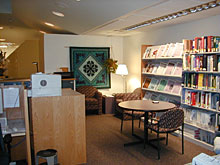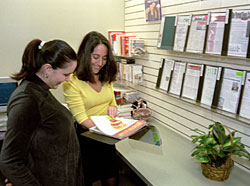In the United States and Canada, hospitals and clinics of all sizes are recognizing the value of patient and family resource centers in meeting consumer information and support needs. A number of trends, prominently the commitment to family-centered care, public interest in health issues, and competition between institutions are fostering an increased interest in developing patient and family resource centers in health care settings. Additionally, the recognition that a better informed patient leads to improved health outcomes furthers the incentive for a patient resource center to strengthen a hospital’s marketing position.
 |
|
|
The Family Health Library, The Children's Hospital, Denver, CO. |
Patient and family resource centers take a variety of forms from one institution to the next. Most begin as a consumer-oriented health library, usually offering information on community resources and services. Many expand to include opportunities for peer support, recreational reading and videos, and a space for rest and reflection. Some settings have extended the concept of a resource center to include concierge services, family sleeping rooms, kitchen and laundry areas, learning labs, and family classrooms. Still others extend themselves outside the health care institution to offer services in satellite centers or other community-based sites and to participate in community programs such as health fairs and school outreach.
 |
|
|
Patient and family resource centers can be a visible, tangible expression of a hospital or agency’s commitment to family-centered practice. |
Key principles of patient- and family-centered care:
People are treated with dignity and respect.
- Resource center staff and volunteers reach out to patients and families in a warm, supportive, and respectful manner.
Health care professionals share complete and unbiased information with patients and families in ways they find useful and affirming.
- The resource center acknowledges the importance and power of information for the health care consumer.
Patients and families build on their strengths by participating in experiences that enhance control and independence.
- Resource center staff and volunteers can assist patients and families in learning how to access useful information through a variety of means.
Collaboration occurs in policy and program development, professional education, as well as in the delivery of care.
- While the resource center is an important source of information and support for patients and families, it can also be the "front door" for how patients and families become involved as advisors for hospital policies and program development.
A Patient and Family Resource Center: Some of the Benefits
“The resources you showed me and the compassion you extended made a difference during the worst time in mine and my family’s lives.” and “I just want to personally thank everyone there in the Resource Center·It helps to know that at times like this there are people out there who can help and will go out of their way to do so·Thank you so much. All of you were wonderful!”
Selection of comments regarding staff gathered through Quality Improvement surveys at the Dana-Farber Blum Resource Center:
"A resource center can provide patients and families with access to information in a variety of formats, in a language that they can understand, and at a reading level that is appropriate for them."
"Patients and families can receive guidance from center staff on how to access information from various databases and the Internet."
"Information is easily accessible so that patients and families can participate knowledgeably in the decision-making process and the provision of care."
"Having a centralized resource center avoids duplication of patient education efforts and can serve as support to many diverse departments within an institution."
"A patient and family resource center can provide the umbrella for childbirth preparation, parenting education, breastfeeding support, and a wide array of educational programs on women’s health issues across the lifespan."
"Well prepared with information they need, patients and families are better able to handle transitions from the hospital and clinic to home and community settings."
"Well-informed patients and families can manage care at home more confidently and competently."
"Potentially, a patient and family resource center can help in reducing the inappropriate use of the emergency department, avoiding a hospitalization or readmission, or reducing the length of stay."
"Patients and families have access to a supportive, comforting, non-clinical setting with individuals whose primary purpose is to provide information and support."
"Many resource centers, patients and families have access to a range of supportive services, including referrals for peer support."
"Resource centers contribute to improved patient and family satisfaction."
"Resource centers typically increase visibility for the hospital or clinic in the community."
"Increased opportunities arise for hospital and clinic partnerships with individuals and agencies in the community to promote the health and well-being of the community."
"Centers provide a referral resource for health care professionals in the hospital and those in the community."
"Resource centers can assist schools, community health nurses, and others in the community with information needs."
"Patient and family resource centers can be the “front door” for inviting patients and families to participate and collaborate in planning, implementing, and evaluating a wide variety of hospital and clinic programs and policies."
Family Resource Centers:
- Hollywood, Florida - The Patient and Family Resource Center at the Memorial Regional Hospital
- Minneapolis/St.Paul, Minnesota - The Cargill Family Resource Center, The Kelsey Lynn Roberg Family Resource Center, Children's Hospitals and Clinics
- Ottawa, Ontario, Canada - The Kaitlin Atkinson Family Resource Center Library, Children's Hospital, Ottawa
- Philadelphia, Pennsylvania - The Connelly Resource Center for Families, The Children's Hospital of Philadelphia
- Seattle, Washington - Family Resource Center, Children’s Hospital and Regional Medical Center
- Boston, Massachusetts - Maxwell and Eleanor Blum Patient and Family Resource Center-Dana-Farber
- Phoenix, Arizona - The Emily Center at Phoenix Children's Hospital
- Chicago, Illinois - Anne Byron Resource Center
- Park Ridge, Illinois - The Women’s Health Resource Center-Advocate Lutheran General Hospital







